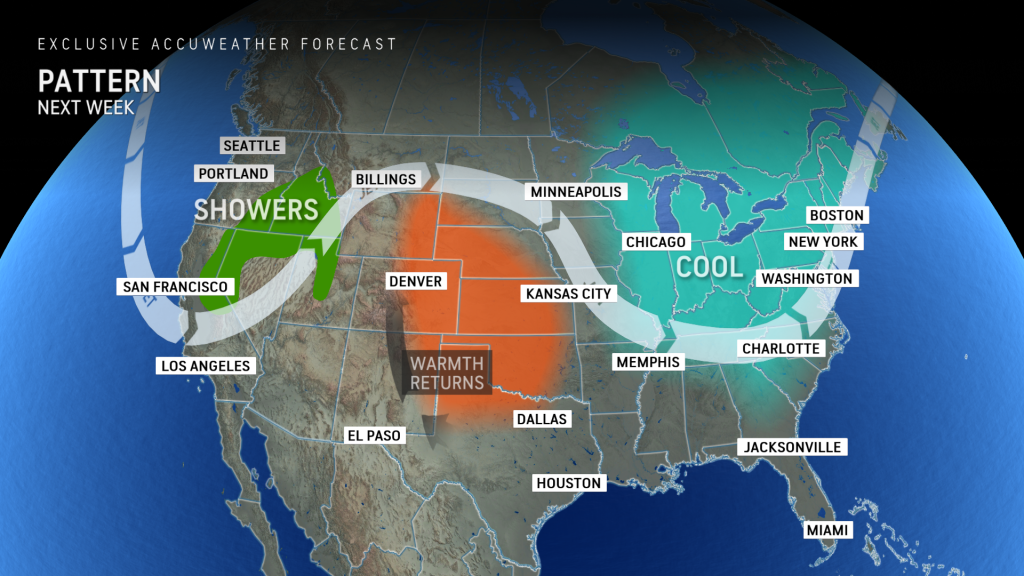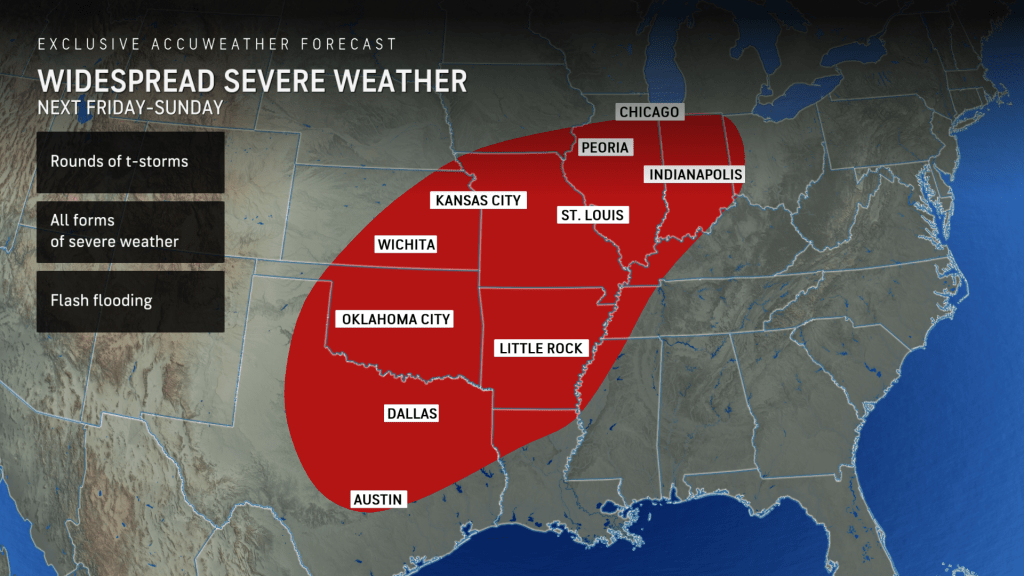AccuWeather meteorologists are available 24/7 to provide further insights and updates on evolving weather conditions. Please contact pr@accuweather.com during regular business hours, or support@accuweather.com or call AccuWeather’s Media Hotline at (814)-235-8710 at any time to arrange interviews with AccuWeather experts or to request the most updated graphics for print or broadcast.
Increasing Tornado Threat as Dangerous Weather Pattern Takes Shape from end of April through First Two Weeks of May
|
|||||||||||
April 19, 2024
AccuWeather Global Weather Center – April 19, 2024
“It’s the time of the year when you don’t have to wait long for one severe
weather outbreak to give way to another one,” warned AccuWeather Long
Range Expert Joe Lundberg. “Springtime is a severe weather time of year
and we expect that this May is going to be no exception.”

The team of expert long-range forecasters at AccuWeather’s Global Weather
Center are monitoring the growing potential for multiple rounds of severe
weather in the final days of April.
“A cold front will move across the Midwest, Ohio Valley, and the Northeast
starting April 23. This front will stall across the south-central Plains and the
northern Gulf States on April 25 and 26. Showers and thunderstorms can
develop along this front in the central Plains,” explained AccuWeather Lead
Long-Ranger Forecaster Paul Pastelok. “Downpours, frequent lightning, and
isolated severe weather with damaging wind gusts and hail can be expected.
An isolated tornado is possible.”
The pattern of stormy weather is then forecast to intensify and expand into
the middle of the nation from April 26 through April 28.

“A strong, slow-moving, storm will rotate through the southern Rockies and
into the Plains in late-April,” said Pastelok. “Warm, moist air from the western
Gulf of Mexico and Caribbean will be pulled northward and meet up with this
intense storm and lead to multiple rounds of severe weather with the threat of
tornadoes.”
AccuWeather long-range forecasters say the positioning and strength of a
surface high-pressure area in the east will be a major factor influencing how
much warm, moist surface air is pulled northward into the Plains and
Mississippi Valley.
“There may be multiple rounds of stormy weather. Widespread severe
weather is our concern developing April 26 and lasting April 27 and 28
anywhere from Austin, San Antonio, Dallas, up to Oklahoma City, Little Rock,
even to Indianapolis,” said Lundberg. “Next weekend could be the start of a
two or three week period of very active weather. There may be multiple
severe weather events through the middle of May in the central and southern
Plains, over to the Mississippi Valley.”
AccuWeather long-range forecasters say the severe weather threat will
expand eastward in the second half of May, which could spawn severe
thunderstorms, hail, and tornado threats in parts of the Ohio Valley and mid-
Atlantic.
“The Tennessee Valley, the southern Appalachians, and even parts of the
Southeast could be impacted. It’s a volatile time of year,” said Lundberg.
Why are more severe weather outbreaks are possible in May?
The influences from an El Niño pattern often lead to fewer tornado threats in
the Plains and Tornado Alley. However, AccuWeather long-range forecasters
say the El Niño pattern that heavily influenced weather in the United States
this past winter is fading fast and will be nearly neutral in May. The change
will allow the northern jet stream to supply upper-level energy into the central
Plains.
Water temperatures are also cooler than the historical average in the
northeast Pacific Ocean, yet warmer in the north-central Pacific. Storms will
track in between the two zones into the Northwest U.S. coast, Central
Rockies, and central Plains through the month of May.
This storm track, combined with influences from warmer waters in the Gulf of
Mexico, more moisture influx, and higher dewpoints will result in an increased
threat of severe thunderstorms and potentially tornado outbreaks.
AccuWeather expert meteorologists say rapid warming of the Great Lakes
this spring, combined with the below-historical average snowpack in the
Midwest this past winter, could lead to a higher frequency of severe weather
threats in the region in May.
The month of May is historically notorious for severe weather outbreaks and
destructive tornadoes. More than 170 tornadoes were reported in America in
May 2023. Severe weather outbreaks led more than 510 tornado reports in
the U.S. in May 2019. A staggering 573 tornadoes were reported in the U.S.
in May 2003.
The team was the first to raise concerns that “Tornado Alley may roar to
life” when the AccuWeather 2024 U.S. Tornado Forecast was issued in
March. AccuWeather long-range forecasters are predicting 1,250 to 1,375
tornadoes in the United States this year, slightly higher than the historical
average of 1,225 tornadoes annually.
Prepare for damaging wind, hail, and tornado threats
With the growing potential for multiple rounds of severe thunderstorms,
powerful wind gusts, damaging hail, and destructive tornadoes, AccuWeather
Senior Director of Forecasting Operations Dan DePodwin says it’s crucial for
families and businesses to prepare early.
“Take the time now to review your insurance policies and take photos of your
home, your vehicle, and important belongings. Having those documents
saved on your phone and uploaded to the cloud can be extremely helpful if
you have to file an insurance claim for storm damage,” said DePodwin.
“Check your garage door track and seals. Garage doors are often a weak
point during severe wind gusts. If your garage door caves in or blows out, you
could end up with serious damage to your roof, which could lead to water
damage throughout your home.”
DePodwin also encourages families and businesses to review and practice a
safety plan.
“Seconds matter when a tornado warning is issued. Identify and set up a safe
space for you and your family to go. You don’t have time to clear out space in
your basement or an interior closet. Make sure your safe place has enough
room, bottled water, and a few snacks for everyone who will need to take
shelter,” said DePodwin. “It’s a good idea to practice getting into your shelter,
especially with kids and pets. Turning a safety drill into a fun experience can
make tornado warnings less chaotic for families.”
More than 315 preliminary reports of tornadoes have been filed across the
United States so far this year.
An AccuWeather analysis of data from the Storm Prediction Center found that
May 25 is the day with the highest number of tornadoes reported. Between
1950 and 2020, 649 tornadoes were reported on May 25, more than any
other day on the calendar.
Tornado activity in the United States usually peaks in late spring and early
summer, but tornadoes can happen any time of year when the weather
conditions are right.
It's important to have multiple ways to receive severe weather alerts,
especially during late-night or overnight storm threats.
AccuWeather expert meteorologists encourage people to get alerts by
downloading the free AccuWeather app.
Never rely solely on outdoor tornado sirens for warnings and alerts; they can
be difficult to hear indoors and can fail during power outages or internet
outages in severe weather.
Additional AccuWeather Resources:
















